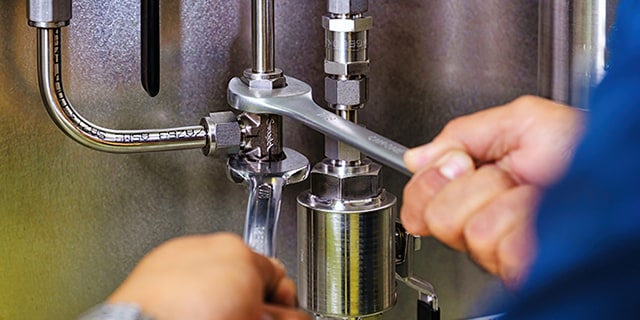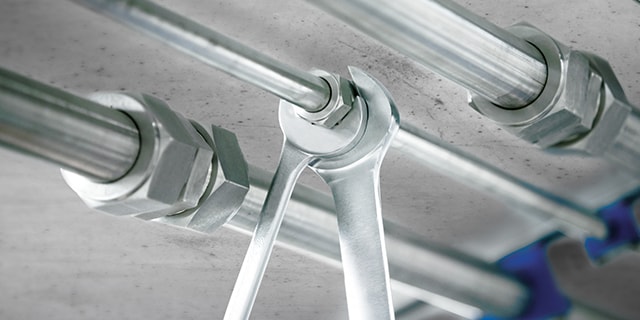Improving Operations with JIP33 Gas Fitting Standards

How the JIP33 Tube Fitting Specification Improves Oil and Gas Operations
Logan Boatright, Senior Global Account Manager, Swagelok
It’s a scenario that every oil and gas operator wants to avoid—but it’s not easy. Delivering complex oil and gas projects on time and on budget requires technical expertise, efficiency, safety, and consistency at every stage. That means minimizing leaks and rework, reducing engineering cycles, and eliminating avoidable cost overruns.
Standardizing component selection is one way that operators can streamline execution and reduce risk—especially on large-scale global projects. And this is the key goal behind the development of gas fitting requirements under the International Association of Oil & Gas Producers’ (IOGP) Joint Industry Program 33 (JIP33) standardizing procurement specifications. JIP33 specifications aim to reduce variation throughout the supply chain and enable greater capital cost control. The IOGP comprises essentially every major oil and gas company, meaning these specifications represent agreed-upon best practices for the most critical applications in the world.
JIP33 specifications set requirements for a broad range of componentry, infrastructure, and systems common throughout downstream oil and gas operations. Among them is Specification S-716, which covers small-bore tubing and fittings—critical components that impact many aspects of an oil and gas facility’s ability to remain safe, efficient, productive, and profitable.
For today’s professionals, the application of this specification when selecting tube fittings for new construction can make a significant impact on any project. With that in mind, it’s worth exploring some of the highlights of JIP33 Specification S-716 and how they can accelerate your project timelines, reduce risk for in the field installation, and ensure you are compliant on your large, cap ex-intense projects. Discover the Swagelok Tube Fitting Advantage.

Avoiding Intermix and Interchange per JIP33
Oil and gas fluid systems rely on thousands of fittings working together to keep operations running efficiently. One major way to maintain that harmony and ensure long-term system performance is to use tube fittings from a single manufacturer. In fact, JIP33 Specification S-716 emphasizes this by stating:
- “Fittings shall be from a single manufacturer.”
- “Intermixing of tube fittings from different manufacturers shall not be acceptable.”
- “Interchanging of tube fittings from different manufacturers shall not be acceptable.”
Understanding why these guidelines matter requires a closer look at the differences between intermix and interchange, and how each can compromise system integrity.
Intermix occurs when tube fitting components (such as nuts, ferrules, and bodies) from two or more manufacturers are mixed to assemble a single fitting. For example, combining tube bodies from one manufacturer with internal components from another would be considered intermix.
In contrast, interchange happens when a complete tube fitting from one manufacturer is installed on a tube, disassembled, and then the tubing, nut, and ferrules are reassembled into a tube fitting body from another manufacturer.
Claims that tube fitting components can be intermixed and interchanged with those of different manufacturers should be questioned. For example, there are no products from other manufacturers that are reliably proven to be “Swagelok-compatible.” Intermixing and interchanging brands is not only costly, but also risky, as doing so may compromise worker safety and system reliability. IOGP has codified the avoidance of intermix and interchange within the S-716 specification for these reasons.
Specifying Compliant Fitting Technology per JIP33
One reason that intermix and interchange can be detrimental is that not all tube fittings are designed and constructed within the accepted definition found within the S-176 specification. The language specifies: “Tube fittings shall be flareless, double-ferrule type.” While many available tube fittings meet this description, not all do. For example, some commonly available tube fittings are designed with a single ferrule. While single-ferrule designs may be suitable for certain applications, a double-ferrule design helps to ensure optimal tube grip strength for the most critical oil and gas fluid system applications.
S-716 further states that tube fittings should be tested following the ASTM F1387-19 standard, which establishes the performance characteristics required for tube fittings in critical tubing systems. It’s another measure by which oil and gas professionals can gain greater trust in the performance of their selected tube fittings.
The Importance of Manufacturer Training and Tools per JIP33
Another important stipulation within the S-716 specification involves adherence to the tube fitting manufacturer’s recommendations regarding training, installation, and other factors. Specifically, the standard states:
- “The tubing system shall be installed by personnel who have been certified by the fittings manufacturer’s approved product training program or equivalent industry training program including hands-on assembly.”
- “Tubing and fittings makeup shall be prepared and marked in accordance with the fittings manufacturer’s recommendations.”
- “Tubing and fittings shall be assembled using the tools recommended by the tube fittings manufacturer.”
Considering these requirements, oil and gas professionals should prioritize working with suppliers who offer not only compliant tube fittings, but also robust training programs and hands-on support. These resources can be a significant value add, helping to ensure fittings are installed correctly and efficiently using the proper tools. Swagelok, for example, has worked with customers to develop tube fitting training programs that meet JIP33 standards and are available globally.
Proper Training Impacts Your Operations
One of the most common sources of fluid system leaks is improper installation practices. A well-trained team of technicians, by contrast, can help eliminate costly reworks and get up-and-running quickly by preventing leaks at the source.
View Technical Tip Videos
Ensuring compliance with JIP33 doesn’t just reduce risk—it builds trust in the long-term reliability of your systems and suppliers.
Interested in learning more about standardizing tube fittings per JIP33 specifications? Swagelok specialists can help. Our engineering teams are very familiar with JIP33 requirements, and Swagelok tube fittings are designed in strict adherence to preferred standards—unlike commonly available single-ferrule options. Get in touch to learn more.
Related Tube Fitting Articles

Why You Should Not Intermix Tube Fittings
Learn why intermixing or interchanging tube fitting components from different manufacturers can lead to poor fluid system performance.

Tube Fitting Spec Update: Improving Safety and Performance
Learn why newly specified attributes for oil and gas tubing and tube fittings can help improve safety and system performance in platforms around the world.

Key Differences in Small-Bore Fittings
Learn the key differences between commonly available tube fitting types used in a variety of applications in this handy introduction to small-bore fittings.

